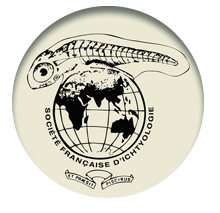Influence of salinity on larval development of Sicyopterus lagocephalus (Pallas, 1770) (Gobioidei)
How to cite: Ellien, C., Valade, P., Bosmans, J., Taillebois, L., Teichert, N., & Keith, P. (2011). Influence of salinity on larval development of Sicyopterus lagocephalus (Pallas, 1770) (Gobioidei). Cybium, 35(4): 381-390. https://doi.org/10.26028/CYBIUM/2011-354-011
The widely distributed amphidromous goby Sicyopterus lagocephalus needs drastic change of habitat to fulfil its life-cycle: adults live and spawn in rivers, where eggs hatch in pro-larvae that have to reach the sea in a narrow temporal scale, to acquire marine characteristics, and begin their oceanic dispersal as planktonic larvae. Post-larvae return to rivers where they recruit and grow to the adult reproductive stage. Such a life-cycle raises the question of salinity changes between these different developmental stages. Through an experimental approach, we observed and described the chronology in the appearance of marine larvae characteristics, according to 5 different salinities ranging, from 0% to 100% seawater. It appears that S. lagocephalus needs an increase of salinity to acquire marine morphological characteristics, without being strict upon the salinity value itself. Whatever the tested salinity, the transformation of freshwater pro-larvae into marine larvae follows the same pattern within 48h: the yolk sac is absorbed until it only consists in the oil globule, pectoral fins develop and become functional, pigmentation spreads above the digestive tract, eyes become pigmented and functional, mouth and anus open, and the head appears more shaped. Pro-larvae behaviour evolves once in seawater: larvae remain on vertical position with their head oriented downwards (i.e., freshwater pro-larval behaviour) but they also spend more time horizontally, after the opening of the mouth, showing a behaviour of horizontal swimming, with acceleration phases, that may be interpreted as a hunting behaviour. Even a low salinity (i.e., less than 10% of seawater) is sufficient to induce these transformations, with the same timing than 100% seawater, leading to the conclusion that we did not underline a minimum salinity threshold for the acquisition of marine larvae morphological characteristics. Moreover, if the pro-larvae, after a first contact with brackish water, secondarily return to freshwater, their transformation is not stopped. However, pro-larvae that remain in 100% freshwater do not develop into marine larvae, neither in their morphological characteristics nor in their behaviour, and they die within 4 days.


